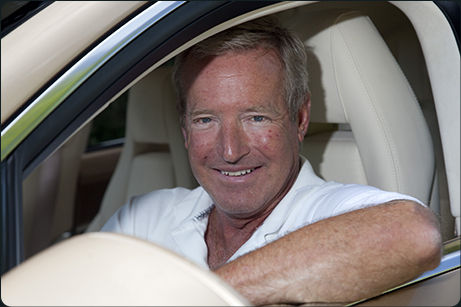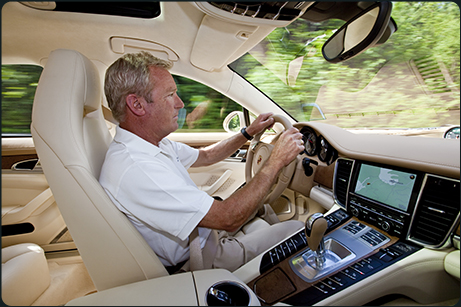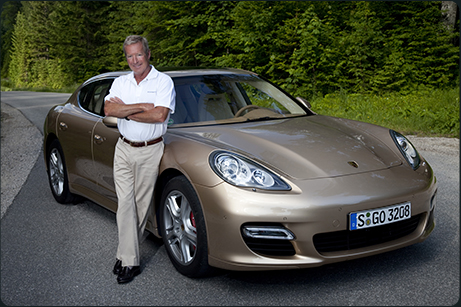International
Sports Car Racing Great Hurley Haywood
Gives Key Driving Tips

Hurley
Haywood has won more grueling sports car endurance race classics than
anyone in racing history, with a total of nearly a dozen victories.
He’s won the 24 Hours of Daytona five times, the 24 Hours of
LeMans in France three times and the 12 Hours of Sebring twice. He was
the first to win the 24 Hours of LeMans and the 24 Hours of Daytona in
the same year. Haywood has appeared in advertisements for upscale
products such as Rolex and television productions for Porsche. Haywood,
who was inducted into the Motorsports Hall of Fame of America in 2005,
long has competed in Porsches. Among other activities, he’s
the chief driving instructor for the Porsche Driving Experience school
that helps motorists become sharper at the wheel. Dan Jedlicka
interviewed Haywood at a Porsche preview of its latest Cayenne and
Panamera models at the Barber race track in Birmingham, Alabama.
Q. What’s the biggest
mistake most drivers make on roads?
A. They just focus on the car ahead of them. They’re looking
at its bumper instead of as far as possible beyond it. On roads and
tracks, I’m always looking ahead, but also to the rear and
sides.
Q.
I’ve followed professional racing drivers on roads and they
always smoothly pull away from traffic around them on, say, freeways,
without speeding or driving recklessly. How do they do that?
A. They’re looking ahead for openings in traffic others
don’t notice and concentrating entirely on driving. Average
drivers should get into the habit of noticing various scenarios around
them. It can keep them from accidents, even save their life.
Q. Do
new, young drivers in America get proper training that enables them to
be good, safe drivers?
A. No. They have awful training, when, say, it comes to handling
emergency situations. They text and talk on a cell phone and are
distracted by friends riding with them. One of the best things a parent
can do for a son or daughter is take them to a high performance driving
school that teaches good car control—how to quickly and
instinctively handle such things as skids and safely avoid or drive
from emergency situations without panicking. In Europe, it can take
four years for a young person to get a permanent driver’s
license. In America, anybody 16 can quickly get a driver’s
license with minimal instruction.
Q.
What kind of car should parents get their kids who have just gotten a
driver’s license?
A. Many kids will want a car that’s flashy and
fast--something “cool” Or cute, like the
small Smart car. But they should be given an auto that’s
safe. For instance, a used Mercedes-Benz or Volvo sedan is safer than,
say, the Smart.
Q.
What affordable cars are popular with young drivers today?
A. Modified Japanese cars. Detroit no longer makes the kinds of
affordable fast cars, such as 1960s Pontiac GTOs, that young drivers
once took to drive-ins and drag raced. So today’s
kids have turned to fast, hopped-up affordable Japanese models.

Q. I’ve found while
doing
some amateur sports car racing that racing on a track and driving on
roads seems very different.
A. In some respects racing is different, but in other respects
it’s no different than driving on roads. For
instance, besides the vision aspect we discussed, smooth driving counts
a lot on both roads and tracks.
Q.
Can you tell just by riding with a driver on the street if he or she
has the potential of becoming a good racing driver?
A. I can tell in about five minutes.
Q.
How can that be?
A. For one thing, a good potential racer is planning moves in traffic.
On tracks, there’s a mixture of small and larger cars that
are traveling at various speeds—just like on roads. Consider
cab drivers. Some are really good, others are terrible. The smooth
ones, for instance, see holes in traffic. They’re not
jerky—on and off the brakes a lot.
Q.
Many young folks who are, for example, outstanding golfers or tennis
players begin playing at a very early age. What about young aspiring
race car drivers.
A. Lots of new racing talent has had much experience racing go-karts.
Go-karts have been with us a long time, but once were used mostly for
recreational reasons.
Q.
Where do they go beyond go-karts?
A. Unfortunately, it’s kind of a hit-or-miss situation in
this country. But NASCAR, for one, has a good “farm
system.” It features various types of race vehicles in
subdivisions that can prepare someone to drive the regular,
most-powerful NASCAR race cars. In Europe, they have various
“Formula” classes that lead up to the ultimate race
cars—found in “Formula One.”
Q.
Did you get started racing go-karts?
A. No. I just got into a car on a track and drove as fast as I could. I
actually started driving my grandmother’s full-size car, with
her permission, when I was 12.

Q. Do you think that
today’s passenger cars have become too technically
sophisticated, overly computerized?
A. Features such as anti-lock brakes and stability control systems help
make cars safer. But it’s true that some computerized
components in cars can be distracting.






